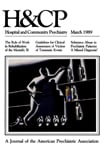An Emergency Psychiatry Update
Abstract
A review of trends in emergency psychiatry since 1981 indicates that the scope and complexity of the field have greatly increased. Clinicians have found it useful to identify patient groups with special assessment and treatment needs, including adolescents, the elderly, victims of rape and of domestic violence, and repeat visitors to the emergency service. The spread of AIDS requires greater medical attentiveness by psychiatric emergency clinicians, and two recreational substances of abuse, cocaine and inbalants, have become increasingly popular. The use of psychotropic drugs in the emergency room has received more attention, and new trends in rapid tranquilization are apparent. Also reviewed are current medicolegal controversies related to emergency room practice, findings on prediction and control of violence, and the use of the psychiatric emergency service as a training site.
Access content
To read the fulltext, please use one of the options below to sign in or purchase access.- Personal login
- Institutional Login
- Sign in via OpenAthens
- Register for access
-
Please login/register if you wish to pair your device and check access availability.
Not a subscriber?
PsychiatryOnline subscription options offer access to the DSM-5 library, books, journals, CME, and patient resources. This all-in-one virtual library provides psychiatrists and mental health professionals with key resources for diagnosis, treatment, research, and professional development.
Need more help? PsychiatryOnline Customer Service may be reached by emailing [email protected] or by calling 800-368-5777 (in the U.S.) or 703-907-7322 (outside the U.S.).



